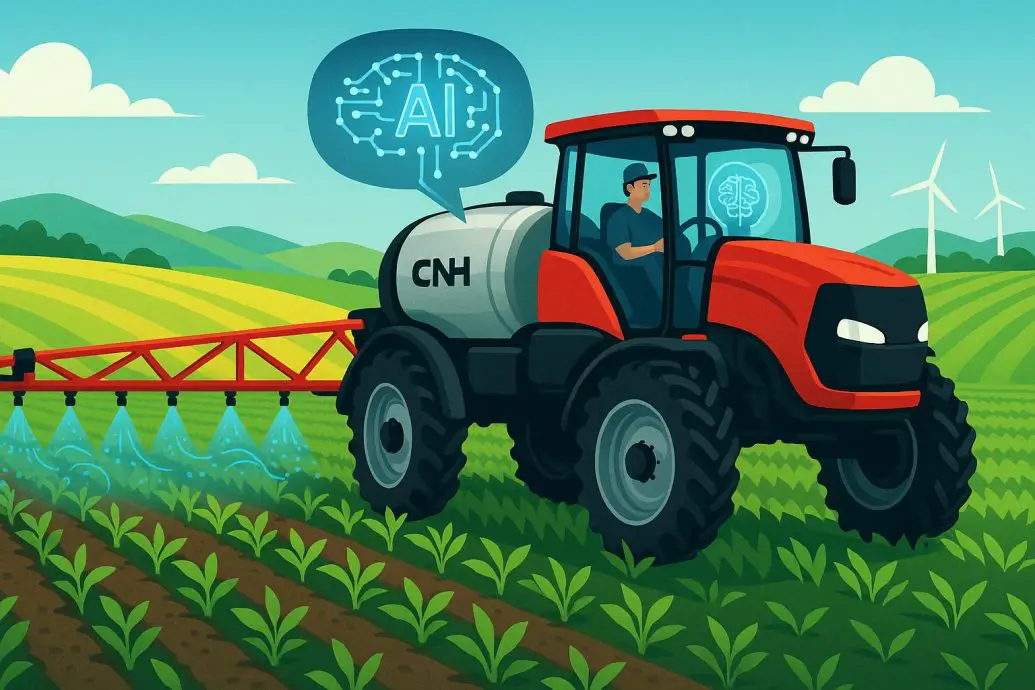CNH Launches AI Sprayer for Smarter Farming
The CNH Launches AI Sprayer for Smarter Farming announcement highlights a major advancement in agriculture. Artificial intelligence and real-time computer vision technologies are transforming the way farmers manage crops. Introduced during CNH’s recent Tech Day, this precision spraying system combines machine learning with targeted application to reduce herbicide use, lower chemical runoff, and encourage sustainable farming. The innovation offers a smart alternative to traditional spraying methods and positions CNH competitively with leaders like John Deere and Trimble.
Key Takeaways
- CNH’s AI sprayer detects and targets individual weeds using real-time computer vision and machine learning.
- The system cuts herbicide use significantly, improving sustainability and reducing chemical waste.
- This smart sprayer is part of CNH’s broader strategy to automate precision agriculture systems.
- Competes with offerings from John Deere and Trimble in the fast-growing AI agriculture segment.
Table of contents
- CNH Launches AI Sprayer for Smarter Farming
- Key Takeaways
- Revolutionizing Weed Control with Smart Technology
- How the AI Sprayer Operates Using Computer Vision
- Comparing CNH with John Deere and Trimble: Who’s Leading?
- A Strategic Move Toward Autonomous Farming
- Industry Perspectives and Market Outlook
- Frequently Asked Questions
- Implications for the Farming Sector
- References
Revolutionizing Weed Control with Smart Technology
CNH’s newest sprayer is redefining what is possible in precision farming. Combining live computer vision with fast learning models, it differentiates between crops and weeds in real time. Spraying is activated only when a weed is identified, resulting in a steep drop in chemical use. This approach saves money and helps protect the environment. During operation, onboard cameras scan and analyze the field at lightning speed. The AI then makes precise decisions in milliseconds, treating only necessary areas and helping maintain healthier crops.
How the AI Sprayer Operates Using Computer Vision
The innovation behind CNH’s sprayer lies in its combination of computer vision systems and embedded AI processors. The process begins with data captured by high-speed, high-resolution cameras mounted along the sprayer boom. The images feed into convolutional neural networks that have been trained on diverse agronomic datasets. The technology uses a mix of RGB and multispectral imaging to distinguish fine details on plant surfaces. Over time, the AI model adapts to real-world conditions in the field. This allows it to adjust to new weed types, soil textures, and lighting conditions to maintain performance. This evolution marks a significant step in the growth of smart farming using AI and IoT.
Comparing CNH with John Deere and Trimble: Who’s Leading?
Entering a highly competitive space, CNH now stands alongside two other notable agri-tech providers. The following comparison outlines several key areas:
| Feature | CNH AI Sprayer | John Deere See & Spray Ultimate | Trimble Smart Sprayer |
|---|---|---|---|
| AI Model | Real-time ML with edge processing | Deep learning for row-level spraying | AI pattern recognition and plant-level detection |
| Imaging Tech | Multispectral + RGB high-speed vision | Dual cameras (RGB) | Optical sensors with edge analytics |
| Targeting Precision | Individual weed identification | In-row and broadcast band detection | Plant-by-plant discrimination |
| Deployment Regions | Europe, North & South America | U.S. focus | North America, Asia-Pacific |
| Herbicide Savings* | Up to 90% reduction reported | 67% less herbicide in trials | Claims 85% savings |
*Based on manufacturer data or third-party pilot studies.
A Strategic Move Toward Autonomous Farming
The AI sprayer launch fits within CNH’s broader push to achieve greater autonomy in farming. The company has made strong moves into automation through acquisitions of firms such as Raven Industries and AgXtend. This approach supports CNH’s development of multiple intelligent systems. These include telematics tools, autonomous tractors, and advanced soil sensors. As part of the shift to robotic agriculture, this innovation adds another building block toward fully automated farming systems.
Industry Perspectives and Market Outlook
“Precision spraying is one of the areas where AI delivers measurable ROI from day one,” said Giulia Alessi, CNH’s Lead Engineer of Computer Vision Integration. Farmers often face rising chemical prices and pressure to reduce environmental influence. CNH’s technology helps address both. Research by MarketsandMarkets projects the smart agriculture industry will grow to over USD 34 billion by 2027. Weed control systems and automation continue to see the strongest increases. These technologies are key in tackling labor shortages and climate-related challenges.
Frequently Asked Questions
What is an AI-powered sprayer?
An AI sprayer uses machine learning and camera systems to identify and spray weeds as it moves through the field. It increases accuracy and cuts excess herbicide use.
How does computer vision reduce chemical use in farming?
By detecting the difference between crops and weeds at a granular level, the system sprays only what is needed. This results in cost savings and environmental protection.
Is CNH’s AI sprayer compatible with existing equipment?
Yes. It is designed to retrofit onto CNH’s supported platforms and sprayers. Availability varies by equipment and geographic region.
Which companies are currently leading the AI agriculture space?
CNH, John Deere, and Trimble are all active in AI-based agricultural tools. Each company takes a unique path with different models and technology stacks.
Implications for the Farming Sector
CNH’s AI sprayer represents part of a larger movement transforming global agriculture. Operators need efficient, intelligent tools to handle shrinking labor pools and worsening climate conditions. Smart systems such as robotic sprayers, sensor networks, and data analytics are helping make this possible. Some of these trends tie closely to the expanding use of artificial intelligence in agriculture. As smart tools gain traction, farmers and cooperatives are being encouraged to evaluate both hardware and software performance during adoption.
